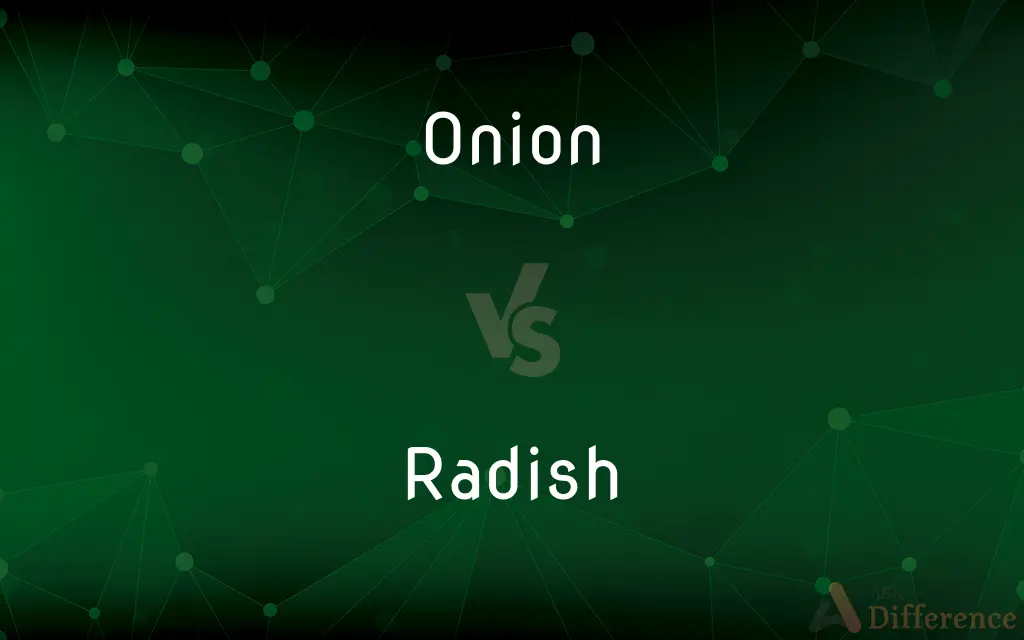Onion vs. Radish — What's the Difference?
By Maham Liaqat & Fiza Rafique — Updated on April 3, 2024
Onions are bulbous root vegetables with a pungent flavor, used as a seasoning or main ingredient, while radishes are crisp, peppery root vegetables, often eaten raw in salads.

Difference Between Onion and Radish
Table of Contents
ADVERTISEMENT
Key Differences
Onions, a staple in many cuisines worldwide, are known for their strong aroma and flavor, which can vary from sweet to very sharp. These layers can be white, yellow, or red, depending on the variety. Radishes, on the other hand, are smaller, round or elongated, and come in a variety of colors including red, pink, white, and black, offering a crisp texture and a peppery to mildly sweet taste.
The culinary uses of onions are diverse; they can be eaten raw, sautéed, caramelized, or used as a flavor base for a wide range of dishes. Radishes are commonly used fresh in salads, as garnishes, or pickled, providing a crunchy texture and a zesty flavor addition to dishes.
Onions are essential in many food preparations, contributing a depth of flavor to soups, stews, and sautéed dishes. They are also used in making sauces and as a condiment. Radishes, while versatile, are often appreciated for their raw, crisp texture and spicy bite, making them a popular ingredient in salads, sandwiches, and as a snack with salt or butter.
Nutritionally, onions offer a good source of vitamins C and B6, manganese, and dietary fiber, with their compounds being linked to various health benefits, including reduced risk of heart disease and certain cancers. Radishes are low in calories and a good source of vitamin C, potassium, and other minerals, and they have been noted for their digestive health benefits.
Both onions and radishes are grown worldwide and come in numerous varieties, each with its unique flavor profile, size, and color. They are both root vegetables but belong to different botanical families, with onions being part of the Allium family, alongside garlic and leeks, and radishes belonging to the Brassicaceae family, which includes mustard and cabbage.
ADVERTISEMENT
Comparison Chart
Flavor
Ranges from sweet to sharp
Peppery to mildly sweet
Culinary Uses
Versatile: raw, cooked, as flavor base
Commonly eaten raw, in salads, or pickled
Texture
Can be crisp or soft depending on cooking
Crisp and crunchy
Nutritional Value
Rich in vitamins C and B6, manganese
Good source of vitamin C, potassium
Family
Allium
Brassicaceae
Compare with Definitions
Onion
A bulbous vegetable known for its strong aroma and layers.
Onions are often diced and sautéed as a base for soups.
Radish
Known for their crisp texture.
Watermelon radishes are sliced for their visual appeal and crispness in gourmet dishes.
Onion
Varied in color and sweetness.
Sweet onions are preferred for caramelizing due to their high sugar content.
Radish
Eaten raw or pickled.
Pickled radishes add a zesty flavor to tacos and sandwiches.
Onion
Consumed both raw and cooked.
Raw red onions are frequently used in salads for their color and bite.
Radish
A small, peppery root vegetable often red or white.
Radishes are sliced thin and added to salads for a spicy crunch.
Onion
Essential for flavor depth in cooking.
Yellow onions are a staple in stock making.
Radish
Enhances dishes with a peppery bite.
Daikon radish is grated into Asian cuisine for its sharp flavor.
Onion
Offers health benefits including antioxidant properties.
Consuming onions can help reduce high blood pressure.
Radish
Supports digestive health.
Eating radishes can aid in digestion and reduce bloating.
Onion
The onion (Allium cepa L., from Latin cepa "onion"), also known as the bulb onion or common onion, is a vegetable that is the most widely cultivated species of the genus Allium. The shallot is a botanical variety of the onion.
Radish
The radish (Raphanus raphanistrum subsp. sativus) is an edible root vegetable of the family Brassicaceae that was domesticated in Asia prior to Roman times.
Onion
A bulbous plant (Allium cepa) cultivated worldwide as a vegetable.
Radish
A swollen pungent-tasting edible root, especially a variety which is small, spherical, and red, and eaten raw with salad.
Onion
The rounded edible bulb of this plant, composed of fleshy, tight, concentric leaf bases having a pungent odor and taste.
Radish
The plant of the cabbage family which yields the radish.
Onion
Any of several other plants in the genus Allium.
Radish
A Eurasian plant (Raphanus sativus) in the mustard family, having a fleshy edible root and white to purple flowers clustered in a terminal raceme.
Onion
A monocotyledonous plant (Allium cepa), allied to garlic, used as vegetable and spice.
Radish
The pungent root of this plant, often eaten raw.
Onion
The bulb of such a plant.
Radish
A plant of the Brassicaceae family, Raphanus sativus or Raphanus raphanistrum subsp. sativus, having an edible root.
Onion
(uncountable) The genus Allium as a whole.
Radish
The root of this plant used as food. Some varieties are pungent and usually eaten raw in salads, etc., while others have a milder taste and are cooked.
Onion
An ounce.
Radish
With a distinguishing word: some other plant of the Raphanus genus or Brassicaceae family.
Onion
A ball.
Radish
The pungent fleshy root of a well-known cruciferous plant (Raphanus sativus); also, the whole plant.
Onion
A watch-seal.
Radish
Pungent fleshy edible root
Onion
A liliaceous plant of the genus Allium (Allium cepa), having a strong-flavored bulb and long hollow leaves; also, its bulbous root, much used as an article of food. The name is often extended to other species of the genus.
Radish
Pungent edible root of any of various cultivated radish plants
Onion
The flavor of an onion{1}.
Radish
Eurasian plant widely cultivated for its edible pungent root usually eaten raw
Onion
Edible bulb of an onion plant
Onion
Bulbous plant having hollow leaves cultivated worldwide for its rounded edible bulb
Onion
An aromatic flavorful bulb
Common Curiosities
How do onions and radishes differ in culinary use?
Onions are used in a wide range of dishes for flavor depth, while radishes are mainly used fresh in salads or as garnishes.
What makes onions and radishes distinct in terms of botanical family?
Onions belong to the Allium family, and radishes are part of the Brassicaceae family, differentiating their botanical characteristics and flavors.
How should onions and radishes be stored?
Onions should be stored in a cool, dry place, while radishes are best kept in the refrigerator to maintain crispness.
Are there different varieties of onions and radishes?
Yes, both vegetables come in many varieties, differing in color, size, and taste.
What is the best way to reduce tears when chopping onions?
Chilling onions before chopping can reduce the release of the irritant compound that causes tears.
How do you pickle radishes?
Pickling radishes involves soaking them in a vinegar solution with salt, sugar, and optional spices.
Can you eat both onions and radishes raw?
Yes, both can be eaten raw. Onions add sharpness to dishes, whereas radishes provide a peppery crunch.
Are onions and radishes nutritionally valuable?
Yes, onions are a source of vitamins C and B6 and manganese, while radishes offer vitamin C and potassium.
What are the environmental impacts of growing onions and radishes?
Both crops are relatively low-impact, but like all agriculture, they require resources and can benefit from sustainable farming practices.
Can the flavors of onions and radishes be substituted for each other in recipes?
Due to their distinct flavors and textures, onions and radishes are not typically substituted for one another in recipes.
What are the main differences between onions and radishes?
Onions have a pungent flavor and are used both as a seasoning and main ingredient, while radishes are crisp with a peppery taste, often used raw.
Can onions and radishes be grown in the same garden?
Yes, they can be grown together, but they have different growing requirements and seasons.
How do the health benefits of onions and radishes compare?
Both vegetables offer unique health benefits; onions are noted for heart health and anticancer properties, while radishes aid in digestion.
Are there any cuisines that particularly favor onions or radishes?
Onions are a staple in many global cuisines for their foundational flavor, while radishes are particularly favored in Asian, European, and Mexican cuisines for their crisp texture and peppery taste.
Do onions and radishes have the same growing season?
Their growing seasons may overlap, but specific varieties may prefer different times of the year for optimal growth.
Share Your Discovery

Previous Comparison
Function vs. Task
Next Comparison
Yippie vs. HippieAuthor Spotlight
Written by
Maham LiaqatCo-written by
Fiza RafiqueFiza Rafique is a skilled content writer at AskDifference.com, where she meticulously refines and enhances written pieces. Drawing from her vast editorial expertise, Fiza ensures clarity, accuracy, and precision in every article. Passionate about language, she continually seeks to elevate the quality of content for readers worldwide.














































